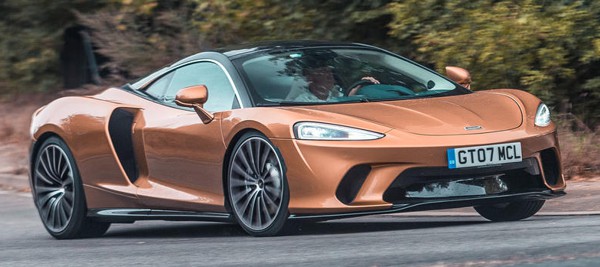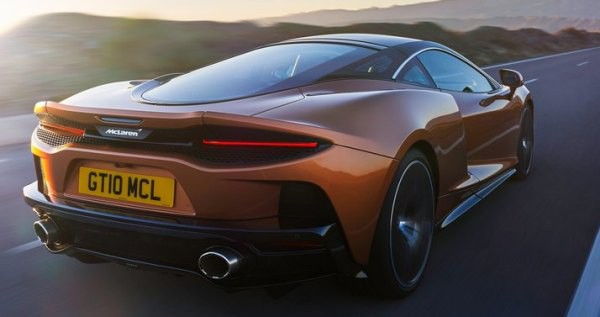| Published
on 11
Feb 2020 |
All rights reserved.
|
|
|

|
|
Nice
GT. Not quite nice as a GT.
|
|
Another day, another new
McLaren. This time the variant is called GT. It is supposed to be a
rival of the grand tourers from Aston Martin, Bentley and Ferrari, but
it seems to have an engine mounted at the wrong position. Yes, despite
the GT moniker, it is still derived from the same formula of all the
current McLarens, which is evident from its looks.
To work like a GT, McLaren did some important changes. Firstly, the car
is shaped to be more beautiful in conventional way. In other words, a
sleeker but less dramatic shape. The aerodynamics development is
oriented to lower drag, hence better high-speed performance and less
wind noise, instead of downforce, unlike a 720S or 600LT. Then, rear
quarter visibility, a weakness of McLaren and most mid-engined cars, is
improved by adding a tiny quarter window at each of the C-pillars, now
glazed. Meanwhile, the cabin is made airier thanks to a panoramic glass
roof, which is also electrochromic. This means the level of
transparency can be adjusted by a switch.
You still enter the cabin through a butterfly door and step across a
wide sill, which is not as easy as a GT supposed to be. However, the
cabin is more luxurious, thanks to standard Nappa leather, more
comfortable seats, an infotainment/climate control with improved
software, upgraded sound system and more sound deadening materials
throughout the cabin.

|
|
Rear
quarter visibility is improved by adding a tiny quarter window at each
of the C-pillars.
|
|
Luggage space is another focus of work. The carbon-fiber tub, now
called "MonoCell II-T" (T for Touring, obviously), has its rear upper
structure modified to enable a storage area resting above the engine
compartment. Though quite shallow, this luggage space is said to
measure 420 liters if you stack the luggage up to the glass hatch,
sufficient to place a golf bag or 2 pairs of skis. Just don’t put
frozen food there, because it is hot. Besides, there is a 150-liter
boot up
front. It is not large enough for your usual suitcases, but you can
purchase
the tailor-made items from McLaren.
At 4680mm, the GT is longer than any McLarens except Speedtail,
although the extra length is spent to the front
and rear overhangs. It is also the heaviest of all, tipping the scale
at 1530 kg, 110 kg more than a 720S. However, compare with Aston
or Bentley, it is still hundreds of kilogram lighter.
The 4.0-liter engine is similar to that of the 720S, but detuned
considerably to 620hp and 465 lbft. Smaller turbochargers, lighter
boost
pressure and a higher compression ratio (9.4:1 instead of 8.7:1) enable
quicker spool-up and a flatter torque curve, although the latter is no
match for the larger capacity engines of Aston or Bentley. Power to
weight ratio is lower than other McLaren sports cars, so performance is
a little tamed by McLaren's standards: it takes 3.1 and 9.0 seconds to
reach 60 and 124mph respectively from standstill. Still, no other GT
cars come close to those figures. The 203 mph top speed is marginally
lower than DB11 AMR or Bentley Continental GT W12, but how many buyers
have the chances to prove?
 |
|
A
420-liter boot sits above the engine. Just don't put frozen food there.
|
|
Predictably, chassis tuning is more oriented to comfort. It retains the
hydraulically interconnected suspensions of the 720S but the tuning is
softer, with
more ground clearance to suit a variety of roads. The steering setting
is
lighter and smoother. The standard steel brakes emphasizes linear pedal
feel. The Pirelli P Zero tires are more friendly to wet surfaces and
generate less road noise. All in all, the GT should offer better
long-distance comfort than any other McLarens.
On the road, yes, the GT is really the most comfortable McLaren to
date. On smoother roads, it rides with a suppleness not unfamiliar with
Aston or Bentley drivers. Engine and road noises are also lower than
ever. The driving environment looks more luxurious, but no one would
confuse it with Bentley or a Mercedes S-class coupe. Despite the glassy
roof, you are still aware of the tightness of the cabin as well as the
limited visibility, which is fine for a supercar but poor for a GT.
Ditto the difficulty to enter or leave the cabin.
Get the engine work harder, its loud and hard-edged scream reveals why
no other GT cars use flat-plane crank V8 – as angry as Maserati Gran
Turismo, it opted to replace the flat-plane crankshaft of Ferrari V8
with a conventional cross-plane crankshaft. Similarly, the power
delivery still lacks the flexibility that a GT engine demands. The
Ricardo-built V8 exhibits more turbo lag than class norm, and its
oversquare combustion chambers, intake and exhaust tuning all promote
high-end power rather than low-down torque. As a result, you need to
wind it
harder to get the same motivation, and the noise is by-product. It
lacks the
effortless manner of its rivals.

|
|
The
agility and communication are true to McLaren. |
|
On rougher roads, the McLaren loses refinement quickly. It dislikes
sharp bumps, potholes and expansion joints commonly found on British
roads, crashing, thudding, jarring and resonating with little reserve.
Now it reveals the downside of a carbon-fiber tub and lightweight
design.
On the flipside, its handling is closer to a supercar. The low
weight, the mid-engined layout and low center of gravity all play to
supercar roadholding, balance and response. It is not quite as sharp or
as grippy as other McLarens, but the agility and communication –
especially the hydraulic steering – are true to McLaren. This is simply
impossible to the much heavier Aston or Bentley. The only
disappointment is the steel brakes, which fades after a few laps.
This means the McLaren GT gets a wrong name. It is not a true grand
tourer but a more comfortable, more practical version of McLaren super
sports car. However, if McLaren wants it to steal customers from DB11,
Continental GT or Ferrari Portofino, it would be more difficult. Even
though it is priced squarely against those rivals at £163,000,
which represents a good value for money, it still lacks the necessary
ingredients to do the job. Ferrari needs 3 platforms to fulfill the
demands of sports cars and GT customers. There must be a good reason.
|
Verdict:     |
|